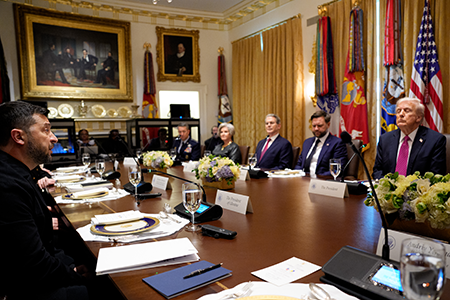Trump Rejects Tomahawk Missile Sale to Ukraine
November 2025
By Xiaodon Liang and Naomi Satoh
After signaling that the United States might transfer Tomahawk cruise missiles to help Ukraine defend against the full-scale Russian invasion, President Donald Trump reversed course, indicating that the Pentagon could not spare its limited stocks of the medium-range weapons.

Ukrainian President Volodymyr Zelenskyy asked for the missiles in a Sept. 23 meeting with Trump. (See ACT, October 2025.) Zelenskyy previously had made a similar request in October 2024 as part of a broader proposal to U.S. President Joe Biden, The New York Times reported at the time.
While flying to Israel Oct. 12, Trump told reporters that, “if the war is not settled, we may very well” transfer the missiles. But in a meeting with Zelenskyy in Washington Oct. 17, Trump rejected the request.
The day prior, Russian President Vladimir Putin had spoken with Trump by telephone. The call lasted more than two hours, according to White House press secretary Karoline Leavitt.
Trump’s public vacillations on the Tomahawk missile come as the president attempts to pressure Russia and Ukraine to agree on a ceasefire.
The Wall Street Journal reported Oct. 22 that the White House recently lifted restrictions on U.S. targeting support for Ukraine’s use of shorter-range cruise missiles provided by NATO allies. In response, Trump said the United States has “nothing to do with those missiles,” in a social media post.
The Biden administration lifted the same restrictions in November, but Trump reimposed them after entering office, the Wall Street Journal said. (See ACT, October 2024 and December 2024.)
Trump also imposed sanctions Oct. 22 on the two major Russian oil and gas firms, Rosneft and Lukoil, barring U.S. companies and individuals from transacting with them. The economic impact of this move will hinge on whether the administration next opts for secondary sanctions on foreign actors that buy or trade in Russian oil.
Although Trump announced following his Oct. 16 phone call with Putin that the two leaders would meet in Hungary in roughly two weeks to discuss resolving the war, a lack of progress in talks at the foreign-minister level have left the summit up in the air, CNN reported Oct. 21.
With a range of around 1,600 kilometers, according to its manufacturer, the Tomahawk would be able to reach many targets in European Russia, including Moscow and St. Petersburg.
The transfer of Tomahawk missiles to Ukraine would “signal the advent of a totally new stage in this escalation, including in terms of Russia’s relations with the United States,” Putin said Oct. 2 speaking at the Valdai International Discussion Club in Sochi.
Dmitry Peskov, the Kremlin spokesman, reacted sharply to Trump’s initial suggestion that he might approve the sale in an Oct. 13 state television interview. If “a long-range missile is launched and is flying and we know that it could be nuclear, what should the Russian Federation think?” he asked, according to Reuters.
The last U.S. nuclear-capable Tomahawk, a sea-launched variant, was retired in 2012.
Explaining his subsequent about-face decision to deny the Ukrainian request, Trump noted that “we need Tomahawks for the U.S., too. We have a lot of them, but we need them,” Russian news agency TASS reported.
Estimates of the U.S. stockpile of Tomahawk cruise missiles suggest the president’s concerns are not unfounded. An analysis published Oct. 17 by Mark F. Cancian and Chris H. Park of the Center for Strategic and International Studies assessed that the Pentagon likely has around 1,360 Tomahawks in its arsenal that are not deployed on ships and submarines.
With annual U.S. production in the low double digits and about 20 Tomahawk missiles destroyed each year in tests and training, the Ukrainian proposal “would make Pentagon planners uneasy about depleting too much of the stockpile,” the analysts wrote.
The Pentagon also does not have many options for providing ground-launchers for the Tomahawk, which primarily serves as a ship- and submarine-based weapon with the U.S. Navy. Despite efforts to rapidly field longer-range, ground-launched missiles after the U.S. withdrawal from the Intermediate-range Nuclear Forces Treaty in 2019, the total number of launchers remains small. (See ACT, May 2024.)
The U.S. Army has produced and equipped troops with two batteries’ worth of Mid-Range Capability Typhon launchers, while the Marine Corps acquired a small number of prototype launchers installed on light vehicles in a separate canceled program. (See ACT, September 2025.)
Despite the Trump administration’s decision to reject Zelenskyy’s request, the United States has been providing assistance to Ukraine’s military campaign against Russian oil and gas industry sites that began this spring, the Financial Times reported Oct. 12. This strategy was intensified after the Aug. 15 Alaska summit between Putin and Trump, according to an Oct. 16 report by CNN.
A BBC investigation found that Ukraine has attacked 21 of Russia’s 38 large petroleum refineries with drones since January, with a sharp rise in attacks in August and September.
Retail oil prices in Russia have increased by 40 percent since January, according to the Oct. 2 BBC report.
Russia has continued launching large-scale drone and missile attacks at Ukraine throughout the year. On Oct. 16, an attack with 300 drones and 37 missiles took Ukrainian gas facilities out of operation, Zelenskyy said in a social media post.
